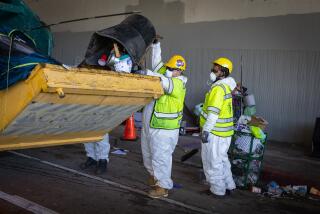Editorial: Stop fighting the Koreatown homeless shelter
When L.A. Mayor Eric Garcetti unveiled his plan to fund shelters for homeless people in every City Council district, Council President Herb Wesson was the first council member to announce that he had found a site on his turf: a parking lot in Koreatown. It’s city-owned (so no private property owner to pay or haggle with), big enough to house at least 65 people, and not bumping up against any residential housing. When it comes to housing homeless people, that’s as close to a dream site as you can get.
Garcetti and Wesson got down to business with encouraging alacrity. The whole point of the shelter plan is to quickly create temporary housing to get homeless people out of squalid street encampments now, rather than waiting the years it will take to build thousands of units of permanent supportive housing. To their credit, council members have agreed to spread the interim dwellings across the city, putting them close to where people are encamped rather than concentrating them in a handful of neighborhoods with little political clout.
But in a portent of the tribulations to come, Wesson’s first-out-of-the-gate plan has stirred an uproar in the Korean community. Opponents — including some residents, business owners, Korean-language media outlets and activists — accused the council president of not consulting community groups before announcing his plan, not holding a public hearing and not supplying many details. Even some of the Korean community groups that joined Wesson at the news conference announcing the shelter plan are now balking, saying they weren’t given enough information about the project.
An online petition opposing the proposed shelter site, 682 S. Vermont Ave., has garnered more than 8,000 signatures. And ugly, racially charged tweets have shown up on social media — “[K]eep them in South Central instead of K Town. In your backyard instead of mine,” reads one.
In Koreatown, which stretches across three council districts (Wesson’s and those of Councilmen David Ryu and Mitch O’Farrell), the common fear of homeless people is overlaid with a resentment that Wesson is just the most recent in a long line of city politicians who give short shrift to the community and its needs.
But here is the bottom line: Koreatown isn’t being asked to do anything that the rest of the city isn’t being asked to do. City leaders have committed to putting these temporary shelters in every district. And that’s just the start — solving the homelessness crisis may not require shelters or apartments in every neighborhood, but it will take far more than one per council district.
There are 368 homeless people in Koreatown by the 2017 homeless count, and they need shelter. And it will be easier and less costly for the city to build a shelter at the site Wesson has chosen than on privately owned land elsewhere.
The proposed site is in an area that already has numerous homeless encampments. And the project will not be the familiar kind of shelter for transients where people line up in the afternoon to get in and get kicked out in the morning; instead, it will provide stable lodging for people waiting for more permanent housing.
It’s one thing for activists in the community to call on Wesson to pay more attention to their opinions. It’s another thing to look for reasons to stop a desperately needed shelter from going up.
Granted, Wesson’s plan got off to a bad start when it didn’t need to. His office—which says it did reach out to more than a dozen groups and churches — could have provided more information sooner to more of the Koreatown community. And the city should have held a public hearing earlier in the process; the first one is scheduled for Tuesday.
These are lessons city and county leaders should take to heart as they embark on an effort to house homeless people at an unprecedented scale. One of the biggest challenges they face is community resistance. To overcome that, city officials have to be careful to let residents understand exactly what’s going on. The first thing the public needs to understand is that their neighborhoods are not being singled out to bear a burden that others won’t bear. Communities all over the city, in every council district, will be home to this kind of shelter and housing. Including Koreatown.
Follow the Opinion section on Twitter @latimesopinion or Facebook
More to Read
A cure for the common opinion
Get thought-provoking perspectives with our weekly newsletter.
You may occasionally receive promotional content from the Los Angeles Times.






